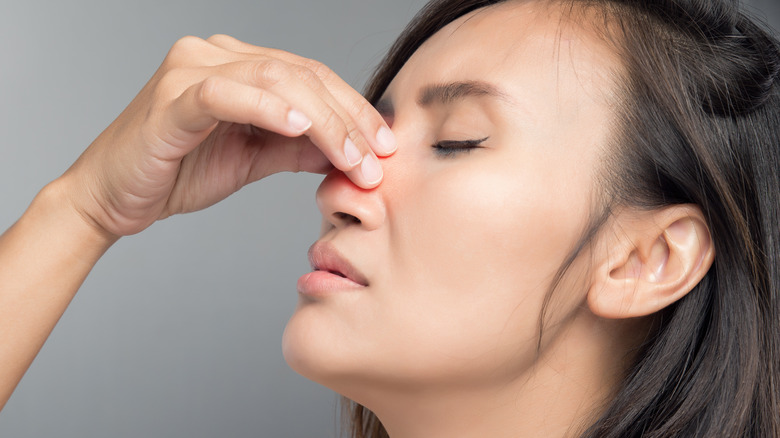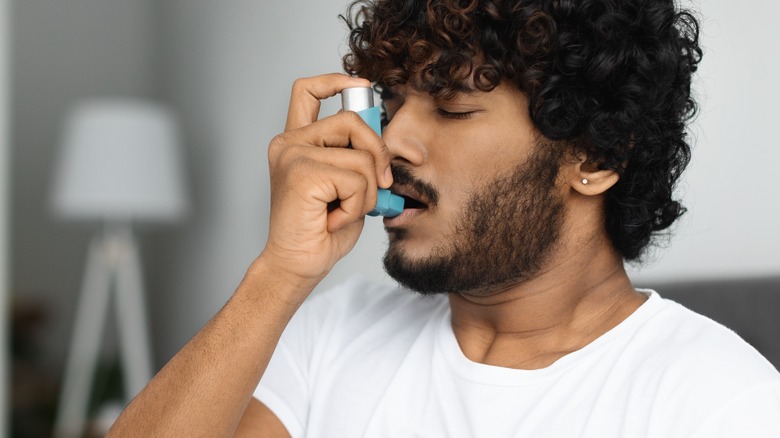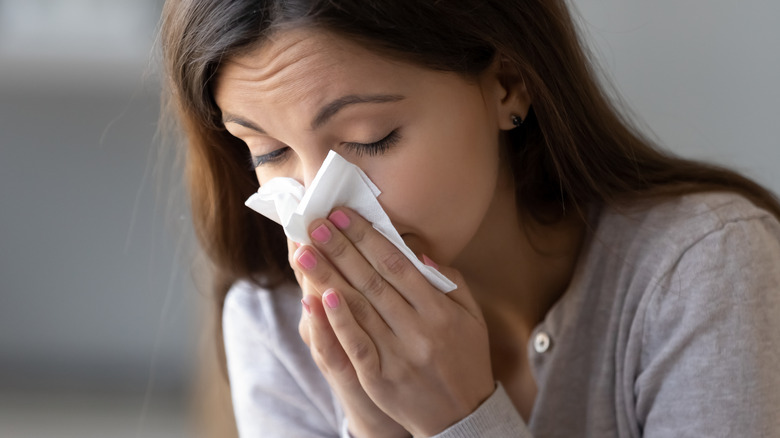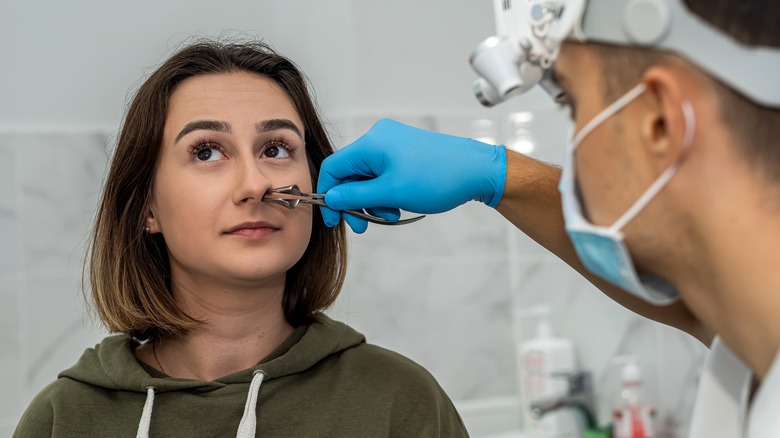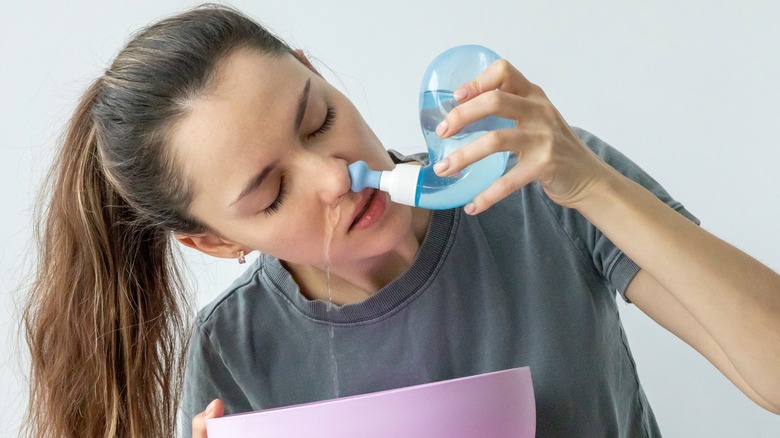Conditions That Make You More Likely To Develop Nasal Polyps
Per the Asthma and Allergy Foundation of America (AAFA), nasal polyps are benign or non-cancerous growths that form in the soft tissue inside your nose or sinuses. They affect about 13 million people in the U.S. They are described as soft and having a grape or tear-like shape that can vary in size. Although nasal polyps can affect anyone, they are more common in middle-aged people assigned male at birth. However, those assigned women at birth tend to develop more serious cases.
Nasal polyps are painless, but can lead to long-term consequences, including blocking normal airflow, anosmia or the loss of your sense of smell, recurrent sinus infections, sleep apnea, and increased risk of asthma attacks, especially when dealing with larger-sized polyps (via the Mayo Clinic). Common signs of nasal polyps include headache, facial pain, or a sense of pressure where your sinuses are located, having a runny or stuffed nose, having mucus drip down your throat, an impaired sense of taste or smell, nosebleed, and snoring. Many of them closely resemble the symptoms of a common cold.
While the exact cause that leads to the growth of nasal polyps is unknown, inflammation plays a key role. Doctors have linked certain conditions with an increased risk of development, like asthma, chronic and allergic fungal sinusitis, nasal allergies, cystic fibrosis, aspirin-exacerbated respiratory disease (AERD), Churg-Strauss syndrome, and vitamin D deficiency. This article takes a closer look at each of these conditions, as well as nasal polyp treatment options and management tips.
Asthma
When you think of inflammatory respiratory diseases, asthma probably makes it to the top of the list. Per the National Heart, Lung, and Blood Institute (NHLBI), asthma is defined as a long-term condition triggered by a specific substance or reaction that leads to an inflammatory response from your immune system. This causes the condition's characteristic swelling and narrowing of the airways, as well as increased mucus production, making it difficult for air to flow in and out of your lungs and creating other common symptoms (e.g., wheezing, coughing, chest tightness).
Given the inflammatory nature of the disease, there seems to be a strong link between asthma and nasal polyps. In fact, according to GoodRx, asthma is one of the leading causes of nasal polyps because the irritation present in the area, along with the accumulation of fluids, facilitates their growth. Nevertheless, this is not a one-way problem. On the contrary, asthma and nasal polyps are more of a two-way deal; once polyps have developed, they add to your body's inflammatory response and worsen asthma symptoms by blocking your airways, leading to more frequent and severe asthma attacks.
Treating asthma and nasal polyps simultaneously is crucial for effectively managing both conditions and stopping the snowball effect that happens between them. To get your asthma under control, the NHLBI suggests identifying and avoiding your triggers, following a healthy diet, exercising regularly, quitting smoking or avoiding secondhand smoke, practicing stress management techniques, and protecting yourself from the flu and COVID-19, which increase the risk of flare-ups.
Chronic sinusitis
When something ends with the suffix -itis, it typically means an associated inflammation. Thus, chronic sinusitis translates to long-term inflammation of the sinuses, but actually refers to long-term infection (via Johns Hopkins Medicine). Nasal polyps are more likely to grow when there is an inflammatory process present; unsurprisingly, chronic sinusitis increases the risk of developing them.
While the exact cause of this link is unclear, the National Heart, Lung, and Blood Institute (NHLBI) shares study results that found that the chronic inflammation associated with sinus conditions may cause genetic changes in the cells that line the passages of your nose and sinuses, leading to the formation of polyps. But according to Healthline, while chronic sinusitis is a risk factor for nasal polyps, the polyps can also lead to sinusitis by blocking mucus flow, increasing the chances of bacterial growth and infection. Roughly 20% of people with chronic sinusitis also develop nasal polyps. Having both conditions at the same time may cause a more significant blockage in mucus flow, which may worsen symptoms such as nasal congestion, facial pain, and anosmia (loss of smell).
Treatment for chronic sinusitis with nasal polyps may involve a combination of medication and surgery. Nasal steroids and saline rinses can reduce inflammation and clear mucus from the sinuses, and oral or topical antibiotics may be prescribed to treat bacterial infections. However, if these treatments are ineffective, you may require surgery to remove the polyps and improve airflow through the sinuses (although they can always grow back).
Allergic fungal sinusitis
Allergic fungal sinusitis (AFS) is a type of sinusitis that is characterized by an allergic reaction to fungi that are commonly found in the environment, most likely microorganisms such as Aspergillus, Mucor, or Rhizopus (via StatPearls). This condition is associated with the development of nasal polyps in a significant number of cases. In fact, they are so closely related that the presence of nasal polyps is actually a major part of the diagnostic criteria.
In AFS, the body's immune system overreacts to fungal spores, resulting in inflammation of the sinuses and the production of thick, sticky mucus (via SpringerLink), which, over time, leads to the formation of nasal polyps. Per a study published in the Journal of the Pakistan Medical Association (JPMA), AFS-associated polyps may appear either on one side (unilateral) or both sides (bilateral) of the sinus cavities and are more common in regions with higher humidity levels. Also, they tend to be more prevalent in people who are in their 20s.
According to Cedars Sinai, the treatment of choice for AFS involves a surgical intervention that allows both the removal of any nasal polyps as well as the elimination of fungal debris and infected mucus. Similarly, the use of steroids may help improve symptoms of infection.
Nasal allergies
When the body is exposed to a common allergen such as pollen, dust, or animal dander, the immune system produces an inflammatory response to protect the body from the perceived threat. In the case of nasal allergies (also known as allergic rhinitis or hay fever), this can cause the nasal tissues to become swollen and irritated, leading to symptoms such as congestion, runny nose, sneezing, and itchy eyes and nose (via Healthline).
Allergies are a common cause of inflammation of the mucosa in the nasal passages and sinuses, which can lead to the growth of nasal polyps (per StatPearls). However, according to WebMD, while allergies are strongly associated with their development, there is still a lot of controversy regarding their connection. Nevertheless, people with allergies have higher chances of developing nasal polyps compared to non-allergic people (per Harvard Health Publishing).
Treating a nasal allergy with polyps may involve a combination of medication and surgery. Medications such as steroid nasal sprays or saline irrigation help control inflammation. In contrast, surgery to remove nasal polyps is reserved for cases when drug therapy doesn't yield the desired results.
Cystic fibrosis
Cystic fibrosis is a genetic disorder that affects different organs within the respiratory, digestive, and reproductive systems (via GoodRx). One of the common respiratory manifestations of the disease is the development of chronic sinusitis and nasal polyps. In fact, according to a study published in Medscape, nasal polyps are estimated to appear in up to 67% of people with cystic fibrosis. As with other causes of nasal polyps, what leads to their growth in people with cystic fibrosis is not fully understood. However, the study explains that the reason is linked to the constant inflammation caused by the disease.
One potential reason behind their growth is that these patients usually have an allergy-like inflammation caused by neutrophils or white blood cells, which may lead to the development of the polyps even in the absence of a specific allergic trigger (via StatPearls). On the other hand, GoodRx explains that in people with cystic fibrosis, the genetic mutation leads to the production of abnormally thick mucus in the respiratory system, which can block the sinuses, impairing their ability to drain properly and leading to the chronic inflammation that facilitates the development of the polyps.
Per the study, nasal polyps due to cystic fibrosis are treated with medications such as nasal steroids, antibiotics, decongestants, or mucolytics (drugs that make mucus thinner). Surgery is evaluated only when these measures don't work.
Aspirin-exacerbated respiratory disease (AERD)
Aspirin-exacerbated respiratory disease (AERD) is a type of chronic inflammatory disorder also known as Samter's triad because it is characterized by the presence of three conditions: nasal polyps, asthma, and respiratory reactions to nonsteroidal anti-inflammatory drugs (NSAIDs), including aspirin, ibuprofen (Advil), and naproxen (via the Mayo Clinic).
Scientists still don't know what causes AERD, but in people with AERD, exposure to NSAIDs triggers the release of chemicals known as leukotrienes, which can cause asthma-like symptoms like inflammation in the nasal passages, which may tighten your airways and make it hard to breathe. Thus, there seems to be a relation with an abnormal inflammatory response in the respiratory system, and inflammation is a known trigger for nasal polyps (via the Mayo Clinic).
Per Healthline, treatment for AERD and nasal polyps may involve a combination of medications, such as nasal rinses and steroid injections, to reduce inflammation and improve breathing. In addition, avoiding NSAIDs is also essential to prevent respiratory reactions. Moreover, surgery may be needed to remove nasal polyps and improve breathing, although this doesn't ensure they won't grow back.
Eosinophilic granulomatosis with polyangiitis (EGPA)
Eosinophilic granulomatosis with polyangiitis (EGPA) (previously known as Churg-Strauss syndrome, or CSS) is a rare autoimmune disorder that is characterized by the presence of inflammation in the blood vessels, which leads to multiple respiratory manifestations, such as asthma, nasal allergies, and sinus complications (via the Mayo Clinic). One of the common features of EGPA is the development of nasal polyps, which may appear in up to 77% of cases (per StatPearls). Moreover, according to a study published in the journal Laryngoscope, nasal polyps in EGPA may be an indicator of the early stages of the syndrome.
Per the Cleveland Clinic, the cause of EGPA is believed to be related to an abnormal immune response that leads to the accumulation of eosinophils (a type of white blood cell) in various tissues throughout the body, causing inflammation that may injure your respiratory organs. Therefore, this is what may promote the development of nasal polyps. In addition to nasal polyps, people with EGPA may also experience symptoms such as skin rashes, joint pain, and gastrointestinal problems.
People who develop nasal polyps due to EGPA should treat EGPA first to make sure they target the cause of their growth (via StatPearls). According to the Cleveland Clinic, said treatment includes a combination of steroid and immunosuppressive medications (drugs that keep your immune system from attacking your healthy tissues).
Vitamin D deficiency
Vitamin D is a fat-soluble vitamin that is important for overall health and well-being. It plays an essential role in the body's ability to absorb calcium, which is necessary for strong bones and teeth. In addition, it helps regulate the immune system, reduces inflammation, and plays a part in the metabolism of sugars, via the National Institutes of Health (NIH). Moreover, research suggests that there may be a link between vitamin D deficiency and the development of nasal polyps.
According to a 2021 study published in the journal Biomedicines, vitamin D's role in regulating the immune system may help reduce inflammatory markers that lead to the development of nasal polyps. In addition, the study found an association between low vitamin D levels and higher levels of inflammation and disease severity in people with chronic sinusitis with nasal polyps. Nevertheless, another study published in the Iranian Journal of Otorhinolaryngology found that vitamin D supplementation may be a safe and successful treatment option to reduce the regrowth of nasal polyps after being removed through surgery.
Treatment for vitamin D deficiency may involve supplementation with the vitamin, either through supplements or dietary sources, such as fatty fish, fish liver oil, or fortified foods like milk and other dairy products (via the NIH).
Nasal polyps diagnosis
Nasal polyps are typically diagnosed through a combination of physical examination and imaging tests of your nose (per the Mayo Clinic). During a physical exam, your doctor may use a nasal endoscope (a tube with a tiny camera) to view the inside of your nose and identify any abnormal growths or inflammation. In addition, imaging tests such as computed tomography (CT) scans are used to provide a more detailed image of the nasal passages and sinuses and can help identify any conditions that may be contributing to the development of nasal polyps, as well as other causes that may be blocking your nose.
Moreover, since the symptoms of nasal polyps can be similar to those of other respiratory conditions such as allergies, sinus infections, and asthma, your healthcare provider may also perform a skin prick test to rule out allergies and a sweat test to rule out cystic fibrosis as potential causes for nasal polyps. Lastly, they may also check your vitamin D levels to make sure you don't have any deficiencies.
Treatment options to shrink nasal polyps
Per CNN Health, treatment options for your nasal polyps may include everything from an at-home approach to prescription medications or surgery, depending on the size and location of your polyps and the cause of your symptoms. Some non-invasive techniques you can try at home include using a humidifier to keep the moisture in your airways and prevent them from drying and becoming inflamed. Also, using nasal sprays or doing nasal washes with saline water helps prevent inflammation by removing irritants and allowing mucus to flow. In addition, avoiding touching your nose with dirty hands can help reduce viral and bacterial infections that promote nasal polyp growth.
If these strategies don't work, your doctor may prescribe some medications as a second line of treatment, including steroid nasal sprays, oral or injectable steroids to help reduce inflammation, and allergy medications such as antihistamines. Furthermore, injectable medications known as biologic therapies also help shrink polyps by reducing localized inflammation when other drugs do not show desired results. Lastly, surgery may be necessary to remove large or persistent nasal polyps or to help keep your airways open by delivering medications to hard-to-reach polyps.
Keep in mind that it is always important to work with a healthcare provider to determine the best treatment option for your individual needs, as they can help you weigh the risks and benefits of each treatment and develop a plan that will effectively shrink your nasal polyps and improve your symptoms.
Tips for living with nasal polyps
Nasal polyp management ultimately comes down to avoiding serious complications, and while some people need a specific treatment to improve their quality of life, it is possible to live with nasal polyps as long as you take some simple precautions. For example, CNN Health recommends following your treatment plan, including taking your meds and attending regular follow-up appointments. Also, make sure to keep your nasal passages moist with nasal sprays, rinses, or a humidifier, and take any necessary steps to avoid allergens or irritants that you know trigger your symptoms.
Moreover, stay on top of any changes in your breathing pattern, which may indicate that your polyps have grown and may increase the likelihood of complications. Additionally, regularly washing your hands and avoiding close contact with people who are sick can help reduce your risk of developing infections that can worsen your polyps. Lastly, under any circumstances, try to remove your polyps yourself, as this may lead to excessive bleeding and an increased risk of infection. Living with nasal polyps can be challenging, but with the right treatment plan and self-care strategies, you can effectively manage your symptoms and improve your quality of life.

